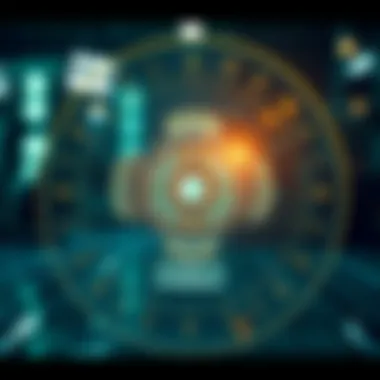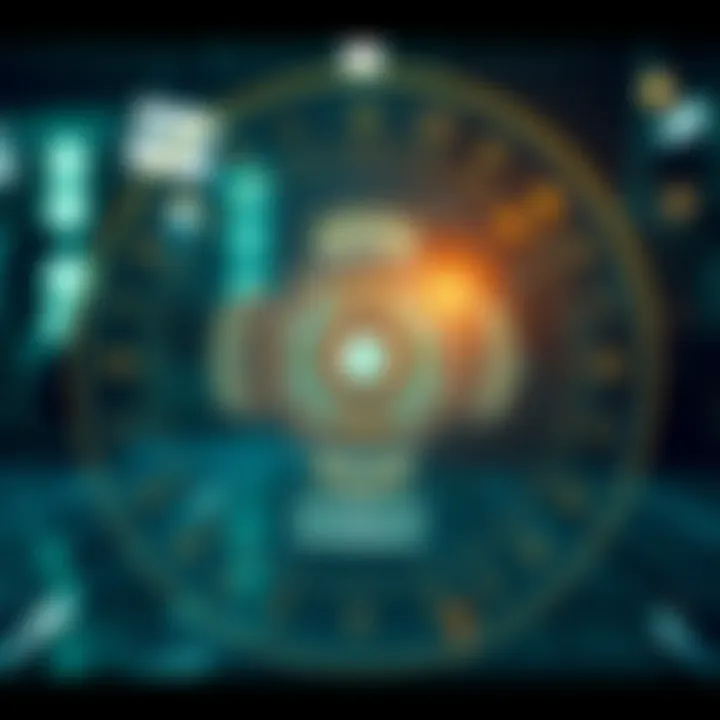D-Wave Computing: Exploring Quantum Innovation


Research Overview
Summary of Key Findings
D-Wave Computing stands as a significant player in the landscape of quantum technology, particularly through its specialized method known as quantum annealing. An integral aspect of D-Wave's approach is its focus on optimization problems. The company claims that its quantum systems can offer solutions more efficiently than classical computers, particularly in scenarios where traditional algorithms struggle. Several studies and tests indicate that D-Wave technology can outperform classical counterparts when dealing with specific use cases.
Furthermore, practical applications of D-Wave systems are burgeoning in sectors such as finance for portfolio optimization, logistics for route optimization, and drug discovery, where analyzing complex molecular structures is crucial. The apparent promise shown in these areas suggests that as quantum computing evolves, it could support an extensive range of industries.
Background and Context
To fully understand D-Wave Computing, it’s essential to appreciate the broader context of quantum computing. Unlike classical bits, which are either 0 or 1, quantum bits or qubits can exist in multiple states simultaneously, a phenomenon known as superposition. This characteristic underpins the unique capabilities of quantum systems, allowing them to process vast amounts of data in parallel.
D-Wave was founded in 1999 as one of the first companies dedicated to quantum computing. Their pioneering work is largely rooted in quantum annealing, a metaheuristic to find the global minimum of a function. While still somewhat in its infancy, quantum technology is rapidly making strides that may eventually redefine computational efficiency. Understanding D-Wave’s contributions requires diving into both the technical details and the innovative spirit fueling this computational revolution.
"Quantum computing is not just a fad; it represents a substantial shift that could revolutionize how we approach problem-solving in computational fields."
Methodology
Experimental Design
D-Wave’s systems leverage a unique architecture called a quantum annealer, specifically built for solving optimization problems. The experimental design utilized by researchers often involves comparing D-Wave’s performance against standard classical algorithms. For instance, optimization problems, such as the traveling salesman problem, serve as a testbed for validating the efficiency and accuracy of quantum annealing.
Data Collection Techniques
Data collection about performance metrics is conducted through precise benchmarking techniques. Researchers gather extensive performance data by executing a multitude of trials across diverse problem sets. Metrics such as solution accuracy, time to convergence, and energy efficiency are key indicators used to assess the effectiveness of D-Wave systems. Additionally, public repositories and specialized databases contribute to a broader understanding of outcomes stemming from practical applications of D-Wave technology.
By synthesizing this data, one can glean insights about D-Wave’s promise and pitfalls, alongside the ongoing journey of quantum computing itself.
As practitioners, scholars, and enthusiasts delve into D-Wave Computing, the conversation will likely focus on both its achievements and the hurdles it faces as it strides further into the realm of quantum innovation.
Preface to D-Wave Computing
In the rapidly evolving landscape of technology, D-Wave computing stands at the forefront, offering groundbreaking solutions that diverge from traditional approaches. This section serves as a crucial entry point into understanding the essence of D-Wave systems, emphasizing the importance of grasping both their capabilities and limitations. By investigating this segment, readers will come to appreciate how quantum computing, particularly through D-Wave's lens, is redefining problem-solving techniques in fields like optimization and machine learning.
Overview of Quantum Computing
Quantum computing represents a paradigm shift in computational thought, harnessing the peculiar principles of quantum mechanics. Unlike classical computers that rely on bits as the smallest unit of data—utilizing either a zero or a one—quantum computers leverage qubits. These qubits can exist in multiple states simultaneously, thanks to phenomena such as superposition and entanglement.
Some of the key characteristics of quantum computing include:
- Superposition: A qubit can be both 0 and 1 at the same time, which allows quantum computers to process information in parallel.
- Entanglement: Qubits can be linked together, enabling the state of one qubit to instantly influence the state of another, regardless of the distance separating them.
- Quantum Tunneling: This feature allows qubits to traverse energy barriers, providing potential advantages in solving certain complex problems more efficiently.
The implications of these characteristics are profound, particularly in tasks that involve massive combinatorial search spaces or difficult optimization challenges. Quantum computing’s ability to analyze large datasets quickly positions it as a powerful tool for various sectors, from finance to pharmaceuticals.
History and Development of D-Wave Systems
The development of D-Wave systems is steeped in a history that reflects the growing interest in practical applications of quantum theory. Established in 1999, D-Wave was among the first to explicitly target quantum optimization solutions, aiming to create a functional quantum computer based on the principles of quantum annealing.
The journey began with D-Wave's early prototypes, sparking interest and skepticism in equal measure. Key milestones in their evolution include:
- 2007: D-Wave claimed to produce the world's first commercial quantum computer, the D-Wave One, which was later validated by external benchmarks yet remained controversial.
- 2011: The introduction of D-Wave Two marked significant advancements in qubit coherence and connectivity, attracting attention from researchers and commercial entities alike.
- 2017: D-Wave unveiled its 2000Q system, integrating 2048 qubits, an impressive leap towards scalability in quantum processing.
Despite criticism concerning the efficacy and potential pitfalls of qubit connectivity, D-Wave has sought to pave pathways for future development. Collaborations with institutions like NASA and Google underscore the commitment to optimize real-world applications, as well as to refine their technology continually.


Understanding this history provides vital context for appreciating how D-Wave Computing is positioned within the broader quantum computing dialogue. As we delve deeper into quantum annealing and its distinct architecture, the significance of D-Wave's innovations will become more apparent, marking a shift not just in technology, but in how we approach computation itself.
Understanding Quantum Annealing
Quantum annealing stands as a pivotal concept within the D-Wave computing framework. Its significance is not merely theoretical, but it offers practical solutions to complex problems that traditional computing struggles to handle. Understanding quantum annealing is crucial for grasping how D-Wave’s technology operates at its core. It leverages quantum mechanics to solve optimization problems more efficiently than classical methods, rendering it a gamechanger in computational tasks.
Principles of Quantum Annealing
At the heart of quantum annealing lies the principle of finding the global minimum of a cost function. Rather than evaluating each possible solution sequentially, quantum annealing employs quantum superposition and tunneling. It allows systems to exist in multiple states at once instead of following a deterministic path. When set into motion, the system slowly transitions or 'anneals' to low-energy states, reflecting optimal solutions to complex problems.
The utilization of quantum mechanics not only enhances speed but also provides a unique perspective on problem-solving. Notably, classical algorithms like simulated annealing depend on random walks and can get stuck in local minima, experiencing delays. In contrast, quantum annealing enables the system to circumvent local optima due to its natural ability to explore state spaces more broadly. This characteristic is what gives D-Wave systems an edge in tackling real-world optimization challenges.
D-Wave's Quantum Architecture
Indeed, the architecture of D-Wave’s machines is meticulously designed to harness the strengths of quantum annealing. This section explores aspects of their architecture, particularly focusing on isolating qubits and connectivity levels, vital to the performance of quantum annealing.
Isolating Qubits
Isolating qubits is foundational for any quantum computer, particularly in avoiding decoherence. Qubits need to maintain their quantum states for as long as possible. In D-Wave systems, isolation is achieved through sophisticated error-correcting codes and precise control mechanisms that mitigate environmental interference.
The ability to effectively isolate qubits ensures that quantum operations yield high reliability. This reliability is increasingly vital, especially when dealing with practical applications ranging from industrial optimization to drug discovery. The unique feature of D-Wave's qubit isolation is that it effectively reduces noise, which can disrupt a fragile quantum computation. However, this isolation comes with its own challenges, such as the increased complexity in managing qubit interactions.
Connectivity and Topology
The layout of qubits within the D-Wave architecture plays a significant role in the system’s efficiency. This connectivity and topology define how qubits interact and communicate with one another. The structured interconnections enable efficient data transfer and manipulation necessary for complex computations.
D-Wave has crafted a unique graph-like topology where qubits are interconnected in a way that promotes optimal coherent interactions. This characteristic allows for the easy implementation of complex algorithms, making it an attractive option for researchers and Industrial applications. Yet, it’s essential to note that this specialized connectivity implies that not all qubits can interact directly, requiring clever mapping of problems to qubit configurations, which can sometimes be a limiting factor.
In summary, understanding quantum annealing and the architectural nuances of D-Wave systems emphasizes how these innovations fuel advancements in tackling some of the most challenging computational problems today.
"Quantum annealing serves not just a theoretical purpose but stands as a working method to approach optimization in real, tangible ways."
Through this lens, readers can better appreciate both the technological innovations at play and the potential it holds for various applications across industries, revealing a rich interplay between quantum mechanics and practical problem-solving.
Technological Innovations by D-Wave
When discussing D-Wave computing, it's crucial to emphasize the technological innovations that have taken place within this space. These innovations have significantly advanced the field of quantum computing, shaping how we approach complex computational problems. The developments in D-Wave's framework hinge on enhancing qubit functionality, refining error correction strategies, and ultimately pushing the boundaries of what is computationally possible.
The breakthroughs made by D-Wave are not only pivotal to the company itself but are also making waves in various industries seeking to optimize operations and uncover insights from vast datasets. Below, we delve into the specifics of these innovations, highlighting the key benefits and considerations that come with them.
Advancements in Qubit Design
At the heart of D-Wave's technology are its qubits, the building blocks of quantum computing. Unlike traditional bits that can hold a value of either 0 or 1, qubits can represent both values simultaneously, thanks to the principles of superposition. D-Wave has made significant strides in qubit design that have facilitated greater qubit coherence and reduced error rates.
Among these advancements:
- Improved Qubit Interactions: D-Wave has refined how qubits interact with one another. This fine-tuning enhances the entanglement quality necessary for complex calculations.
- Room-Temperature Operation: The ability to operate qubits at higher temperatures (compared to other quantum systems) simplifies the practical implementation of quantum computing in real-world applications.
- Scalability: Enhanced qubit designs have improved the scalability of quantum processors. This means more qubits can work together effectively, allowing for more complex computations without significantly increasing error rates.
These advancements not only boost the computational power of D-Wave systems but also expand their applicability across different sectors like finance, logistics, and beyond. The result is the capability to address problems that were previously out of reach for classical computers.
Error Correction Mechanisms
Another pivotal area in which D-Wave excels is error correction mechanisms. In quantum computing, errors are a common hurdle due to decoherence and other factors that can alter qubit states. It's vital to implement strategies to minimize these errors and ensure reliable computations.


D-Wave employs several techniques for error correction, including:
- Redundant Qubits: By utilizing redundancy, D-Wave can mitigate the effects of erroneous qubit operations. If one qubit fails, others can act as backups to maintain the integrity of the computation.
- Quantum Error Correction Codes: These codes are designed to detect and correct errors that occur during computations without requiring a complete reset of the quantum state.
- Adaptive Error Mitigation: D-Wave has developed algorithms that can dynamically adjust computations in response to detected errors, thereby improving outcomes in real-time.
"The next important frontier for D-Wave is achieving error rates that approach the thresholds necessary for large-scale quantum error correction, leading to practical deployments of quantum applications."
Incorporating effective error correction not only enhances the reliability of quantum computations but also inspires confidence in potential users across both scientific and industrial fields. As D-Wave continues to innovate, the expectation is to see a future where quantum computing becomes as reliable as classical computing in critical applications.
Thus, technological innovations in qubit design and error correction mechanisms lay the groundwork for D-Wave’s mission to transform industries. As these technologies develop, the implications for computational efficiency and problem-solving capabilities become increasingly profound.
Applications of D-Wave Computing
The potential applications of D-Wave Computing are transforming industries and opening doors to innovative solutions. Quantum annealing, the cornerstone of D-Wave’s technology, shines a light on problem-solving across various sectors. By harnessing quantum properties, D-Wave systems tackle complex optimization problems that classical computers struggle with, allowing for advancements in efficiency and effectiveness. The implications are profound, making it essential to explore how these applications create value in real-world scenarios.
Optimization Problems in Industry
Optimization problems are at the heart of many business challenges, where the aim is often to find the best solution from a sea of possibilities. D-Wave plays a significant role here, particularly in two critical areas: logistics and supply chain, and financial modeling.
Logistics and Supply Chain
Focusing on logistics and supply chain, D-Wave systems introduce a new layer of complexity management. These systems can process intricate data sets to determine optimal routes, reduce delays, and improve resource allocation, which are crucial for operational efficiency. The characteristic flexibility of D-Wave computing allows for real-time adjustments, which is something traditional methods often fall short of achieving.
The unique feature that stands out in logistics optimization using D-Wave is its ability to handle dynamic variables. For instance, if a shipment route is disrupted due to weather conditions, D-Wave can quickly recalibrate and propose alternative routes. This adaptability is a significant advantage, making D-Wave a compelling choice for industries heavily reliant on logistics.
However, it is worth noting that while D-Wave provides promising solutions, there are challenges. Integration into existing systems can be complex and costly. Despite these hurdles, the benefits of increased efficiency and improved decision-making processes often outweigh the initial teething pains.
Financial Modeling
Turning to financial modeling, D-Wave also demonstrates its prowess. The ability to model complex financial scenarios, involving countless variables, is vital for investors and analysts alike. D-Wave systems can optimize portfolios, forecast risks, and assess asset correlations with remarkable speed and accuracy. Especially in volatile markets, these systems show a potential that classical methods simply can’t match.
The key characteristic of D-Wave within financial modeling is its proficiency in processing vast amounts of data to find hidden patterns. By identifying correlations that may go unnoticed through conventional analysis, businesses can make informed decisions in real-time, leading to more strategic investments.
A unique aspect of applying D-Wave in finance is its speed. Classical algorithms often take significant time to process complex calculations, while D-Wave can dramatically reduce this time frame, leading to quicker results. Nonetheless, the commitment to a quantum system necessitates an understanding of its limitations. For example, while beneficial, the current maturity of quantum algorithms demands careful interpretation of results. Misinterpretations can lead to erroneous conclusions, which is a risk organizations must navigate.
Machine Learning and Data Analysis
In the sphere of machine learning, the capabilities of D-Wave are groundbreaking. The system is leveraged to enhance data analysis processes, enabling faster training of algorithms and helping to automate decision-making. With the innovative power of quantum computing, large datasets can be handled more efficiently than traditional methods.
The characteristic advantage of employing D-Wave for machine learning lies in the depth of scenarios it can analyze simultaneously. Instead of taking sequential steps as classical machines do, D-Wave explores multiple paths at once due to its quantum nature. This ability to evaluate various outcomes simultaneously leads to faster insights, a game-changer for data-driven industries.
Pharmaceutical Research
Pharmaceutical research stands to gain tremendously from D-Wave applications. The complex nature of drug development relies heavily on simulations and modeling, both of which can be significantly accelerated with D-Wave technology. By improving the accuracy of biochemical simulations, researchers are able to identify potential drug candidates more rapidly.
The impressive capability of D-Wave in handling computationally intensive simulations sets it apart. It can model interactions within biological systems quickly, allowing scientists to focus on the most promising compounds. This results in a reduction of time and costs associated with research and development.
Yet, it’s crucial to keep in mind the ongoing need for collaboration between quantum computing experts and domain specialists. Realizing the full potential of D-Wave in pharmaceuticals necessitates a blend of quantum knowledge and biological insights.
"The applications of D-Wave Computing exemplify the transformative power of quantum technology, redefining how industries tackle complex problems."
In summary, the applications of D-Wave Computing span across multiple industries, offering advanced solutions to age-old challenges. From optimizing logistics to revolutionizing financial modeling, the impact is far-reaching. Similarly, its significant role in machine learning and pharmaceutical research highlights D-Wave's promise. As these applications continue to evolve, they present opportunities that might reshape the landscape of computation for years to come.
Comparative Analysis with Classical Computing


In the rapidly evolving field of computational technology, examining the differences between D-Wave's quantum systems and traditional classical computing is paramount. Understanding this comparative analysis provides crucial insights into the strengths and limitations of quantum systems, especially within the context of complex problem-solving. As industries continue to adapt and innovate, the relevance of this comparison becomes increasingly significant. By discerning how D-Wave's technology enhances or challenges established norms, one gains a broader perspective on the future of computational capabilities.
Strengths of D-Wave Systems
D-Wave systems offer a variety of strengths that distinguish them from classical computers, particularly in specific areas of computational demand:
- Speed in Optimization Tasks: D-Wave's quantum annealer excels at solving complex optimization problems that are especially challenging for classical computers. For instance, in logistics and route optimization, where multiple variables interact, D-Wave can find optimal solutions faster than classical counterparts.
- Handling of Large Datasets: Where classical methods may struggle, D-Wave's approach allows for more effective handling of large datasets. This quality is invaluable in machine learning applications, where the capacity to analyze and derive insights from vast amounts of data quickly is needed.
- Exploration of Solution Spaces: The inherent design of D-Wave systems enables them to explore multiple solutions simultaneously. In contrast, classical computers typically evaluate potential solutions sequentially, which can considerably slow down the process.
Notably, D-Wave’s architecture encourages deeper exploration in fields like pharmaceuticals and material science, where various molecular combinations can be tested swiftly. Such advantages underscore the viability of integrating quantum systems into everyday applications.
Limitations and Challenges
Despite their numerous strengths, D-Wave systems also face significant hurdles when compared to classical computing systems:
- Unique Application Scope: While they perform exceptionally in specific scenarios like optimization, D-Wave systems are not universally applicable to all computational needs. For instance, traditional programming tasks may still be best suited to classical systems.
- Error Rates and Stability: Quantum computing is still maturing, and parts of D-Wave's systems are susceptible to errors and instabilities due to qubit interactions and operational temperature conditions. This instability poses a challenge for consistent results across various applications.
- Complexity of Programming: Programming a quantum computer may necessitate a different skill set than traditional programming. The unique principles of quantum mechanics can deter developers who are already accustomed to classical paradigms, potentially stunting widespread adoption.
Overall, while D-Wave presents remarkable advantages in certain domains, the limitations highlight the importance of integrating these systems alongside classical computing rather than as complete substitutes.
The discourse on these comparative analyses not only outlines the current landscape but also paves the way for future enhancements as both realms evolve.
"The real power of computation lies in understanding when to leverage classical systems and when to pivot towards quantum solutions."
For further reading, you might consider resources like Wikipedia or articles on platforms like Britannica to deepen your understanding of how D-Wave systems interact with traditional computing methodologies.
The Future of Quantum Computing
The landscape of computing is on the precipice of a paradigm shift. As quantum technology advances, it carries the potential to redefine not just the performance metrics of systems, but also the very fabric of computation itself. D-Wave, a significant player in this field, illustrates how quantum computing can resolve complex problems in moments that classical systems would require exhaustive computations to address. The exploration of the future of quantum computing is not merely an academic exercise; it's a critical discussion that informs decision-makers in businesses, governments, and research institutions. This section delves into crucial elements that underscore the trajectory of quantum computing, focusing specifically on trends and collaborative efforts.
Trends in Quantum Technology
The evolution of quantum technology is marked by several standout trends that no one can afford to overlook.
- Increased Commercial Interest: More businesses are investing in quantum computing, seeing its potential to gain an advantage in optimization, simulation, and large data analysis. Companies like Google and IBM are expanding their quantum computing programs, giving rise to robust ecosystems.
- Focus on Hybrid Systems: Many researchers advocate for a hybrid approach to harness the best of both classical and quantum worlds. This means utilizing classical computing for tasks where it excels, while shifting the more complex problems to quantum systems.
- Development of Quantum Algorithms: New algorithms are continually being developed to maximize the performance of quantum systems. Notably, Variational Quantum Eigensolvers (VQE) and Quantum Approximate Optimization Algorithms (QAOA) are at the forefront of innovation in this sector.
- Growing Quantum Workforce: Educational institutions are adapting to the demand for knowledge in quantum computing. This shift is evident in the introduction of specialized courses and degrees, fostering a new generation of quantum scientists and engineers. The skills developed here will prove invaluable as industries increasingly rely on quantum technologies.
"Quantum computing is not just an evolution, but a revolution in the way we think about computation and information processing."
- Enhanced Hardware Development: Companies like D-Wave are scaling resources to create more stable and reliable qubit designs. This progress significantly influences computational power and efficiency, allowing for larger and more complex problem-solving capabilities.
Potential for Collaboration in Research
Collaboration often springs from necessity, and in the field of quantum computing, it's essential to link various expertise from across domains. The potential for partnerships among industries, academia, and government institutions creates a fertile ground for innovations that can leapfrog current limitations.
- Interdisciplinary Research Initiatives: Projects that blend physics, computer science, math, and domain-specific knowledge are vital. This convergence promotes a comprehensive understanding of challenges and opens the door to innovative solutions.
- Shared Resources and Facilities: By utilizing shared quantum labs, research groups can accelerate experimentation while pooling resources. Joint grants and funding opportunities can full utilize institutional capabilities, reducing the overall financial burden.
- Networking and Symposiums: Engaging the quantum community through conferences fosters relationships and enables the sharing of ideas. Events such as Q2B Annual Conference provide a platform for experts to exchange insights and forge lasting partnerships that can drive the field forward.
- Government Collaboration: Regulatory bodies are actively collaborating with quantum start-ups. This synergy not only enhances research but also ensures that ethical considerations are prominent as the technology develops.
Ending
D-Wave Computing stands at the intersection of theoretical physics and practical application, offering a glimpse into a future reshaped by quantum technology. The exploration of this subject has made clear that D-Wave's unique approach to quantum annealing is not merely an academic curiosity — it presents significant potential to influence various sectors. From optimization problems across logistics to advancements in pharmaceuticals, the implications of D-Wave's systems offer a refreshing perspective on how we understand computation.
Recapitulation of Key Insights
Throughout this discussion, various key insights into D-Wave Computing have surfaced, emphasizing its importance in contemporary technology:
- Quantum Annealing: This method offers solutions to complex problems more efficiently than classical counterparts.
- Technological Innovations: Breakthroughs in qubit design and error correction are paving the way for more robust systems, enhancing reliability.
- Real-World Applications: Industries are beginning to leverage quantum computing capabilities for data analysis, demonstrating the tangible benefits of this technology.
- Collaboration Potential: As quantum research advances, the capacity for collaboration in academia and industry presents an essential avenue for continued growth and innovation.
"The potential of quantum computing is immense, setting the stage for breakthroughs that could fundamentally alter the landscape of technology."
Final Thoughts on D-Wave's Impact
As we look into the crystal ball of quantum technology, it is clear that D-Wave is forging a path that many will follow. As researchers and industry professionals engage with this technology, the shared insights and discoveries will only accelerate the adoption of quantum systems. The challenges posed by this revolutionary technology are substantial, yet they offer fertile ground for innovation and collaboration. The question now is not whether quantum computing will have an impact, but rather how swiftly it will transform and enhance the realms of science, technology, and daily life.







